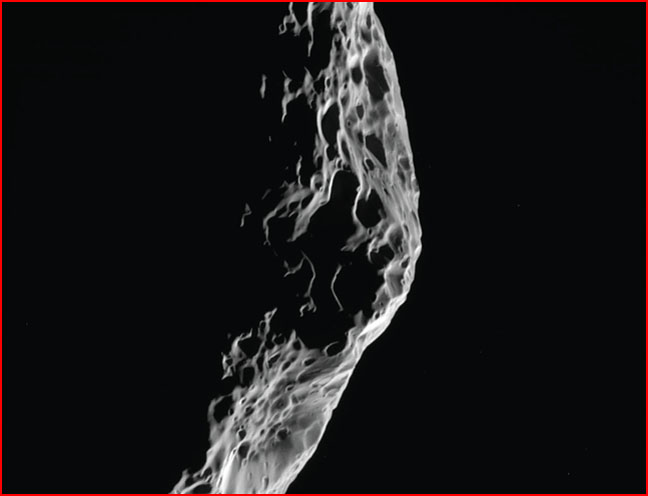
home •
about •
essential guide •
picture of the day •
thunderblogs •
news •
multimedia •
predictions •
products •
get involved •
contact
picture of the day archive subject index
Saturn's deeply cratered moon Hyperion, as imaged by the Cassini probe in 2005. Credit: NASA/JPL
Jul 23, 2007
Homing in on HyperionThe Cassini space probe to Saturn has observed dark organic deposits inside craters on the small moon Hyperion. Now, new evidence suggests the material may have come from another moon--Iapetus.
We have featured Hyperion in past Thunderbolts Pictures of the Day because of the anomalous cratering and sponge-like texture of its surface. But another mystery has arisen. Recent images acquired by the Cassini space probe reveal dark organic deposits collected in the bottom of some its craters. No one knows what the actual materials are except in terms of their elemental composition, though NASA scientists have emphasized that they are all necessary components for life.
An irregular celestial body with approximate dimensions of 328 x 260 x 214 kilometers, Hyperion is smaller than Dione, Tethys or Iapetus, which have all been the subjects of recent Pictures of the Day commentary because they appear to exhibit electric discharge effects. The many unusual craters, steep conical walls and tubular excavations on Hyperion all point to multiple disruptive events that have carved the moon into its present cavernous shape. Craters of varying sizes cover its entire surface, some measuring several kilometers in diameter. And this poses once more the question we we have asked in the past. How does an object of such a small size and of such a porous nature sustain multiple impacts blasting out craters nearly as large as the object itself, without being blown apart?
In reflecting on images taken in Cassini's close approach, NASA scientists have suggested that Hyperion may have acquired its dark-stained material from its sister moon, Iapetus, though the means by which this may have occurred are far from clear. On September 10, Cassini will once again make a close flyby of Iapetus, and the scientists will be looking again for answers to the question. The probe with return once more on October 21, 2007.
From the standpoint of the Electric Universe theory, transportation of charged dust and gas (more accurately called plasma) between planetary bodies is not a unique condition. It has been considered in these pages many times as an explanation for the collection of sulfur ions from Io in Jupiter's plasmasphere and for the exchanges of atmosphere between Titan and Saturn. Since Hyperion and Iapetus are both orbiting within Saturn's intense electromagnetic field, and Iapetus shows evidence of massive excavation by electric arcs, the dusty debris expelled from its surface could easily find its way along a charged pathway to its neighbor Hyperion.
So far, Enceladus, Tethys and Dione have all been found to be "geologically active," though just a few years ago it would have been considered absurd to apply that phrase to Saturn's small moons. In the Electric Universe proposed by Wal Thornhill and his colleagues, the present activity is largely electrical, all pointing to past events that would have been orders of magnitude more energetic. The sputtering of dust that we see today pales by comparison with the violent events of Saturn's past. And it is this ancient activity within the Saturnian system that will account for the abundant scars dominating all of Saturn's moons.
By Stephen Smith
___________________________________________________________________________Please visit our Forum
The Electric Sky and The Electric Universe available now!

|
|

|
EXECUTIVE EDITORS:
David Talbott, Wallace Thornhill
MANAGING EDITORS:
Steve Smith, Mel Acheson
CONTRIBUTING EDITORS: Michael Armstrong, Dwardu Cardona,
Ev Cochrane,
C.J. Ransom, Don Scott, Rens van der Sluijs, Ian Tresman
WEBMASTER: Brian Talbott
Copyright 2007: thunderbolts.info
![]()
home •
thunderblogs •
forum •
picture of the day •
resources •
team •
updates •
contact us

